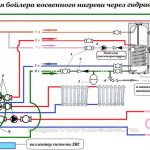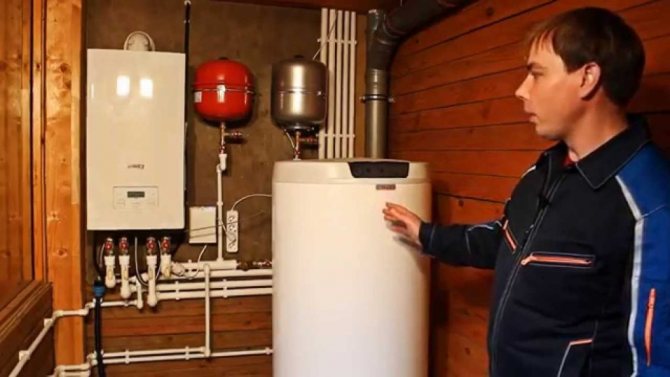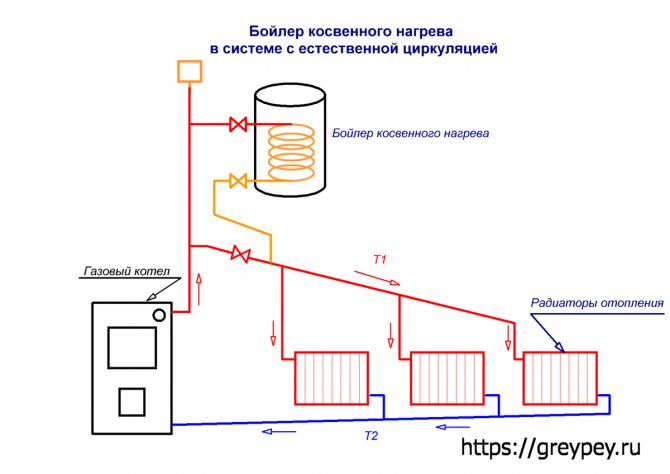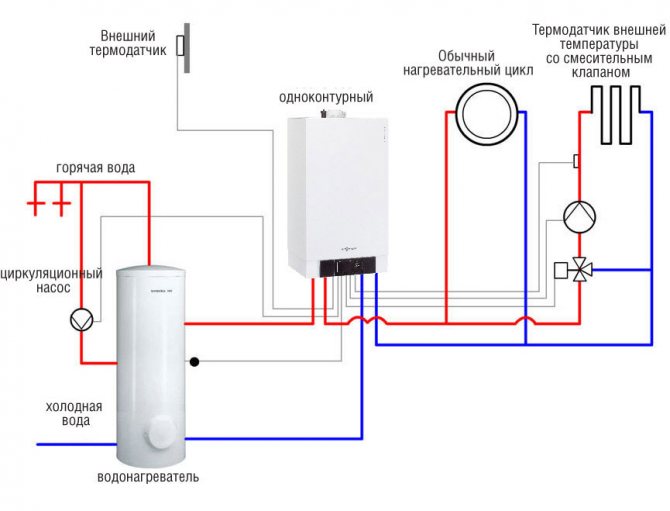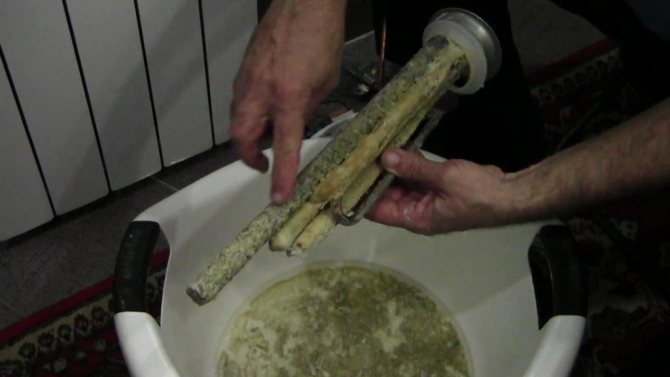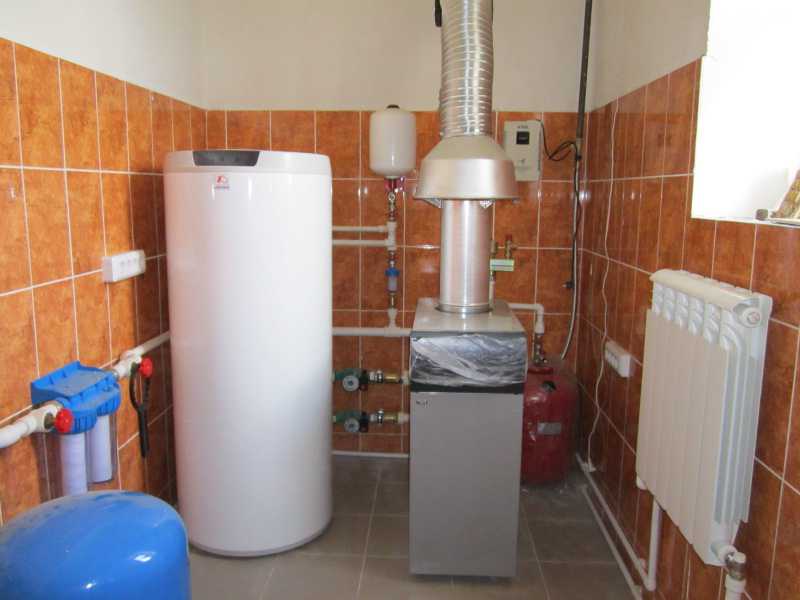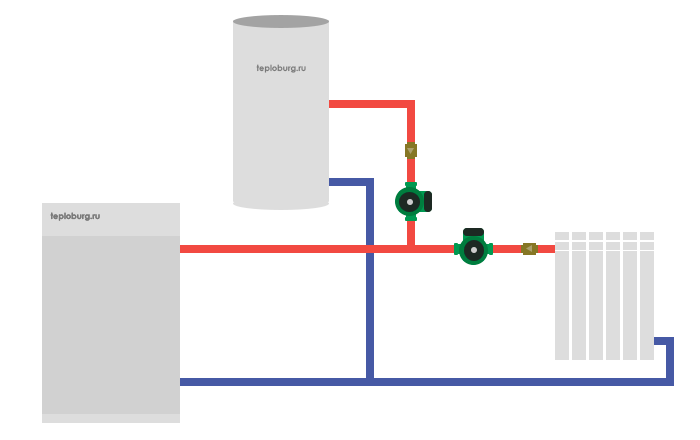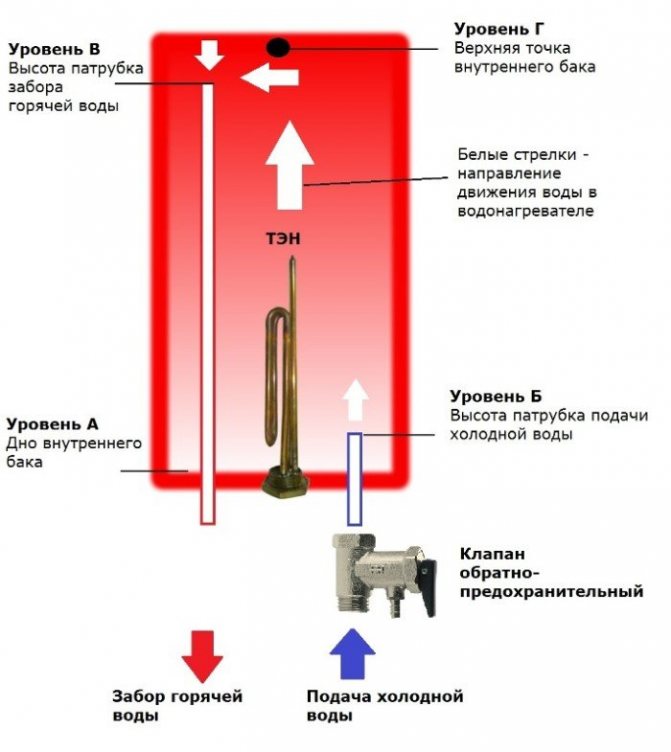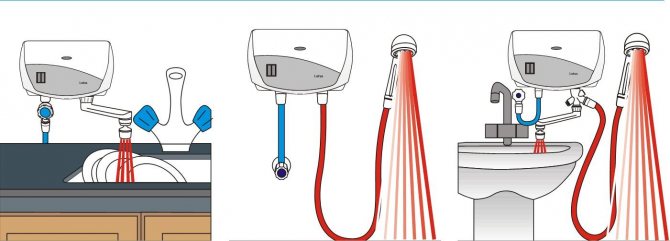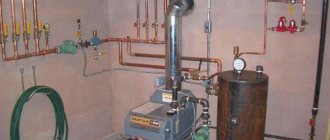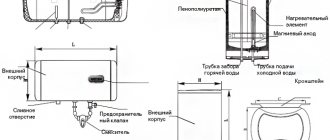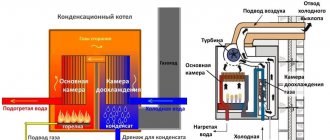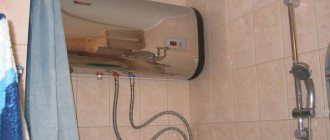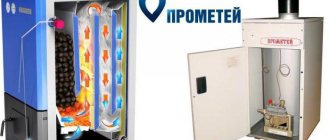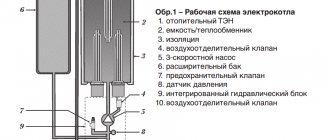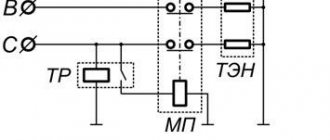Cleaning indiscriminately
The method is suitable if the contamination is not too significant. To renovate the inside of the boiler and remove limescale, you will need:
- fill the tank only 1/3, heat the water in it to 95 degrees;
- open the drain connection and connect a hose through which the cleaning solution will be supplied to the container;
- the hose must be fixed at any point above the tank and left in this position for several hours;
- drain the working solution and rinse the reservoir with clean water.
To completely remove the remaining solution, you need 4-5 tank volumes, after which the water heater can be used as usual. The water for flushing should be warm - about 25-35 degrees. It is unacceptable to use for any purpose water from a boiler that has not been washed after using a chemical solution.
With collection
The method is relevant if the scale layer is already too thick and it will not be possible to dissolve it chemically. Before starting work, prepare:
slotted and Phillips screwdrivers;
wrench;
sandpaper;
screwdriver;
cleaning agent.
It is most convenient to dismantle the water heater with an assistant. Do not forget about precautions: use gloves when applying chemicals to surfaces, and special masks to protect the respiratory system from acid fumes.
Disconnecting the device from the power supply and draining the remaining water as follows:
- first of all, close the tap, which is responsible for supplying water to the room;
- the valve that stops the supply of cold water to the water heater is closed;
- a hose is connected to the hot water pipe through which the remaining water is drained.
In the next step, you can start opening the tank. The bottom panel of the device is removed, the wiring is disconnected, after photographing the location of the wires in order to connect them accurately during assembly. The elements holding the heating element are unscrewed and removed: first, the bolts of the bar are unscrewed, and after removing the remaining water, the heating element is taken out. If there is too much scale, and it interferes with the removal of the heating element, it is permissible to scrape it off first with a knife, and then pull out the part.
The heating element that is now in the hands can be cleaned in 2 ways:
- Mechanical - used with a loose layer of scale. Most of the plaque is removed with a knife, and the rest is scraped off with sandpaper. However, the heating element must not be polished too much, as there is a risk of damaging it. Scale must be removed while it is still damp, as it will be less susceptible after drying.
- Chemical - the scale is scraped off with a knife, and after the heating element is placed in a solution to remove such deposits. There he remains for several hours.
Principle of operation
Single-circuit gas boilers with an indirect boiler operate in two main connection schemes. The principle of operation of the first is as follows:
- The three-way valve dominates here. A pump is installed directly into the outlet of the gas boiler, which circulates and builds up pressure. The next step is to install a three-way valve, which is connected to the boiler thermostat. When heating tap water or other coolant, its flow is directed to the heating system, and priority is given to the ingress of hot medium into the boiler coil. This is done using an additional, second pump.And it turns out that in this case the hot water supply and the heating system are connected in parallel, and they can form two circuits, in this closed chain. And after the boiler, an additional pump is installed, which helps to regulate the operation of the thermostat. The principle of starting and stopping the process is also controlled by a thermostat, namely, with strong heating, a forced shutdown of the fuel supply occurs, when the coolant cools down, the fuel is passed again, and the burner is automatically ignited.
- If there is no double circuit and priority is not given to heating hot water, the boiler is mounted in a common system, installed in a convenient place, and water is heated on a par with all radiators.
You will be interested >> The principle of operation of a floor-standing gas boiler
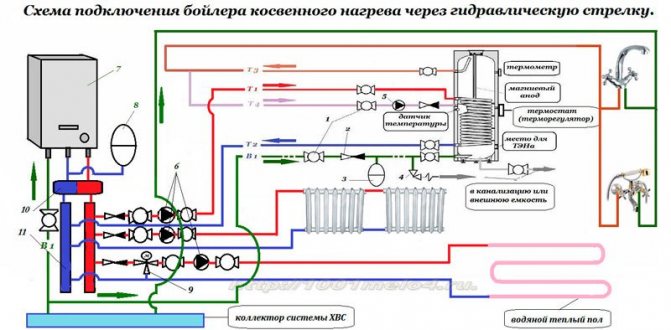
Professional cleaning
Any used agent, which contains alkalis and acids, can completely remove old scale and rust.
When cleaning water heaters, the following means are used very often:
- salt;
- silite;
- filtero;
- master boiler;
- topperr 3031;
- bagi Kumkumit;
- eon Bio.
Before using these drugs, you must carefully read the instructions. If the concentration of the substance is too high, the water heater may fail.
When is it time to clean the boiler?
As a rule, the water heater gives "warning signs" 2-3 years after installation. During this time, a layer of lime accumulates on the heating element.
The fact that the boiler needs cleaning may be indicated by:
- increased energy consumption and water heating time;
- there was a hiss during the operation of the device;
- the water has lost its transparency, it seems rusty;
- the water smells like hydrogen sulfide;
- floating scale particles are visible in the water;
- the tank cover has started to heat up.
If in the area where you live, the water hardness is higher than 350 mg / l, then it is recommended to clean the inner surface of the water heater once a year. Sometimes the water is very hard, so additional cleaning is required at intervals of 5-6 months.
Completeness
In a double-circuit - everything is there.
As a rule, a double-circuit floor-standing gas heating boiler is already equipped with everything you need: a circulation pump, a safety valve, a membrane expansion tank and fittings. All that is needed to install such a mini-boiler room is to supply gas, pipes with water and a pipe for removing combustion products.
In a single circuit - everything is separate.
Not only do you need to buy additional equipment, but you also need to install it in a boiler room, which requires a considerable area. Wall-mounted single-circuit boilers are more convenient in this sense - they already have some of the necessary components, it remains only to connect a water heating boiler for the DHW system with protection elements.
Single-circuit.
You need a place - both for the boiler itself and for the expansion tank, pump, safety valve. Considering not only the size of the system, but also its unaesthetic appearance, it is better to place it away from eyes. At the same time, the installation of both boilers itself will not be difficult for a good specialist.
Article Rating
How to clean an indirect heating boiler at home.
Over time, one way or another, you have to carry out cleaning procedures. The appearance of a rotten smell, a weakening of the pressure - all these are sure signs that problems in the serviceability of the equipment are beginning to appear, and in order to minimize them and, if possible, correct them, it is necessary to carry out preventive measures. The correct solution would be to flush the boiler. Use the required chemicals. In this way, you remove the original cause of the breakdown and raise the overall quality level.Systematic inspection of equipment and regular procedures for cleaning the boiler from rust, trapped debris and scale will ensure the longest possible service life. You can carry out cleansing procedures both in a specialized service and at home. If the need arises, cleaning can be done by your own efforts, without calling the master.
How often the boilers need to be flushed.
Manufacturers always leave instructions for use in the operating manual. In particular, there is always a clause that explains all the nuances in carrying out cleaning procedures. BKN must be cleaned on average once a year if no serious breakdowns are observed that affect the serviceability of the equipment. It may smell like rotten eggs when warm and hot water is used. Also, a decrease in temperature for heating water, the appearance of rust can be a sign. If you find any of the indicated signs, then you urgently need to stop further operation of the equipment and carry out maintenance. The frequency of cleaning procedures is influenced by the following circumstances: Output quality.
When and how often should the boiler be cleaned?
It is imperative to clean the device. Almost everywhere, tap water is very hard and contains salts, which are constantly deposited on parts. In view of this, the boiler needs to be cleaned regularly, otherwise it will simply fail. But how to understand that it is dirty? The device requires cleaning if:
- It took longer than usual to heat the water.
- Electricity consumption has increased dramatically.
- The water heater began to suddenly turn off, and then turn on on its own.
- The water changed color: it became yellow or dark.
- The water began to smell unpleasant.
- The device began to work, making loud sounds, "hiss".
- Even if there are no listed problems, but the water heater has been regularly used for more than a year, then it is imperative to clean it.
Frequency of equipment operation.
In the case of tanks used in industry, things are a little different. Unlike using BKN at home, when using water heaters in industry, it is recommended to carry out cleaning procedures at least twice a year: Before the start of the season and immediately after Serious equipment breakdowns are best left to specialists. Call the wizard to fix the problems. However, cleaning procedures can be carried out with your own hands. You need to check the tank for all sorts of debris and foreign objects, establish the consequences of operation in the form of scale and rust. If you have a need for minor repairs and you are confident in your abilities, then you will need the simplest set of tools for repairing plumbing.
Recommendations
A boiler or a water heater itself is a rather expensive unit and therefore, improper assembly can lead to the purchase of either a damaged part or a completely new heating device. But if you correctly approach the issue of cleaning, then you can easily do it at home. As recommendations, the following points can be noted:
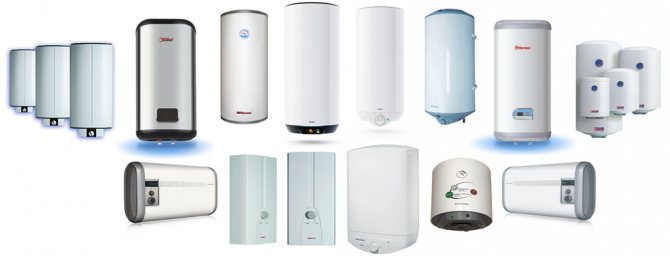

- To be sure that the contacts are connected correctly, it is better to photograph them before disassembling.
- After disassembling the water heater, it is imperative to study all the details and carefully examine them. Some may need to be replaced.
- If the heating element after cleaning still could not be brought to the proper state, then it is better to simply replace it with a new one.
- When using special cleaning agents for the heater, it is imperative to read the instructions for its use.
- To avoid frequent cleaning, it is recommended to purchase water filters to eliminate various impurities.
- After assembly, before connecting the boiler to the network, make sure that the water tank is completely filled.
How to empty a boiler
The instructions for use indicate the need for cleaning procedures at least once every 6 months. This is guaranteed to protect the equipment from most breakdowns and seriously reduce the chances of lime scale appearing, thereby extending the life and improving the quality of work. The preventive maintenance manual clearly indicates the sequence of actions to be taken: 1. Shut off the low temperature water supply. 2. Open the hot water tap. 3. On the outlet piping, the relief valve must be open to remove all liquid from the equipment. 4. After all the contents of the boiler have been taken out, you can proceed directly to cleaning the equipment with your own hands and without the help of specialists. 5. You need to remove all foreign particles that have accumulated on the bottom of the equipment during operation. At the same time, it is advisable to check the general technical condition of the tank and all the parts in it. Various procedures for cleaning a water heater are not particularly difficult to perform. You can use a hose with water after disconnecting the tank from the power supply. If the specified cleaning method did not solve your problem and calcium deposits are visible on the equipment, then there is a need to purchase means for cleaning BKN. You can purchase ready-made chemicals at specialty hardware stores or household chemicals stores. You can also make your own flushing fluid using some of the ingredients that almost everyone has. You will need vinegar or citric acid. Pour the agent into the tank and in most cases this will be enough, you can completely clean the agent without taking it out of service. It is only necessary to turn off the water supply for a while and follow the flushing instructions: 1. Shut off the water supply. 2. Empty the tank by a third. 3. Connect the hose to the drain pipe. 4. Use chemicals. 5. Place a funnel over the end of the hose. Before removing the cleaning agent, raise the hose so that it is not below the water level. After using chemistry, you must fill the container with water and let it stand for about half an hour. After that, it is necessary to start the boiler and heat the heat exchanger to approximately 40-45C, then wait an hour. Then you need to fill the tank with water twice in a row and empty it. It is recommended to press the system after flushing procedures. Conditions of increased pressure are created in the tank, exceeding the operating level. This is done in order to check the equipment for all sorts of malfunctions. The procedures must be carried out by disconnecting the boilers by the hydrostatic method of pressure = 1.5 from the working pressure, but exceeding 0.2 MPa (2 kgf / cm at (2Ati)) at the bottom. t-ke Sis-we.
Requirements for the location of such a boiler
Single-circuit gas boilers are subdivided into floor-standing and wall-mounted, and, depending on the model purchased, there will be special requirements for the room:
- For wall-mounted single-circuit gas installations, it is necessary: the presence of at least one window in the room where the boiler itself will be located;
- you need to mount a chimney;
- the boiler is best located near the boiler.
- equipment of a separate room;
You will be interested >> Description of the floor-standing boiler Proterm Medved


How to descale a boiler
Not all scale can be removed with reagents; therefore, there are other ways to remove deposits. In the absence of the necessary maintenance, calcium deposits appear on the equipment. The procedures can be performed at home using a special pump, or in the service, in which case the equipment must be disassembled. All necessary equipment for dry cleaning is divided into two types: household. industrial. A flushing pump, regardless of its type, is quite expensive, in this regard, buying it to clean one water heater becomes unprofitable from a financial point of view. However, it is not possible to achieve the same, simply pouring a chemical reagent into the container. The pump is necessary for high-quality flushing of the coil. For maintenance, you can use the following reagents: 1. Sulfamic acid - often used in the manufacture of tools for prompt cleaning of equipment from scale. It should be noted that the dissolution of this substance will require a water temperature of at least 60C. At the same time, the product is cheap and is sold in special granules. On average, buying one bag will cost you about 200 rubles. 2. Citric acid is a popular and effective folk remedy. Recommended for use in less advanced cases, i.e. in case of moderate scale. Substitution with vinegar is allowed if necessary. The main prerequisite for effective flushing is regular maintenance. To ensure the prevention of limescale, it is recommended to carry out a similar procedure twice a year. Among the advantages, one can single out a safe impact on the surface of the equipment. In fact, there is no risk of damaging the surface. For best results, follow the instructions for use. Pay particular attention to the recommended mixing ratio.
How to flush a water heater to eliminate an unpleasant odor
After a couple of years of regular use, a characteristic smell resembling rotten eggs (hydrogen sulfide) may appear. The aroma appears only when the water is heated to high temperatures. It will no longer be enough just to rinse the equipment and clean the surfaces to eliminate the unpleasant stench. The stench occurs due to a malfunction of the BKN, therefore, first of all, it is necessary to find out the cause of the breakdown. There can be several reasons for this smell: 1. Bacteria. Water temperature in the range of 30-40C creates ideal conditions for the development of various microorganisms. To cope with this problem, it is necessary to heat the water to about 70C at least once or twice a month. In the presence of a built-in electr. Heating element up to 90-100C. 2. Magnesium anode. Although this device is a prevention against the appearance of scale, over time, the core begins to rot, which as a result leads to an unpleasant odor. The way out of this situation will be to replace the anode. Use any detergent to remove odor. After refilling the container with water, turn on the water heater at full capacity for about an hour. This procedure is guaranteed to eliminate the odor, provided that you have eliminated the cause of the occurrence.
How to clean without disassembling
In the case when it is not possible to disassemble the heating device, and lime deposits have penetrated not only the heating element, but also the walls of the boiler, other measures can be taken using various means.
It is worth saying that there are many different means for cleaning a water heater. Among them are the following:
Folk
The simplest remedies are citric acid and ordinary table vinegar (consumption is about 250 milliliters per 10 liters), which allow not only to remove scale from the water heater, but also help to eliminate the unpleasant odor. And the important point is that the indicated funds are always at home, so you can clean the boiler at any time.


Professional
As for professional products, you can buy them in the store. It is written on them for how long they need to be placed in the boiler. It is important to remember that the water in the water heater should be at the time of cleaning with the agent to the very top. Otherwise, the heating device will only be half clean. You can also use electric kettle cleaner because the principle of operation is exactly the same. You can read an article about cleaning products for an electric kettle here.
We also advise you to read: 5 ways to clean the bath from yellow plaque at home
Mechanical
In this case, mechanical cleaning of the boiler directly with your own hands implies the use of a brush with a hard metal pile, or you can use a knife to clean off scale on the heating element, if it is presented as a tubular electric heater. But you need to clean it very carefully, since the heating element is very easy to damage.
How to flush the boiler so that there are no bacteria
You don't need any special products to get rid of various bacteria. You can use the most common soap solution for processing. If necessary, you can use absolutely any detergent for washing, which does not contain acids. A good option and a replacement for expensive products will be a dish detergent. The time-tested way to eliminate legionella bacteria is to run the boiler at its highest power. It is advisable to carry out this procedure every six months. Most of the various bacteria and pathogenic microorganisms die at high temperatures and are washed out with water. Timely maintenance of the water heater guarantees you a long service life of the equipment.
Examples of applications
Back to
Cleaning technology
To clean the heater from dirt and limescale, it is imperative to follow the algorithm of actions, since the appropriate cleaning technology is provided. It lies in the fact that you need to carry out:
We also recommend reading: How to clean a washing machine at home from scale, mold, rust
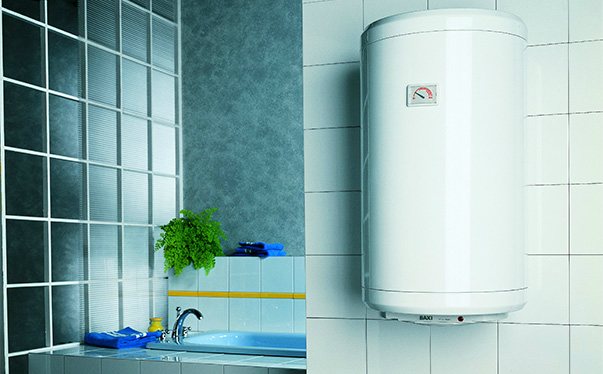

Draining
Before starting cleaning work, it is imperative to drain the water from the water tank. How to do this procedure correctly is noted in the instructions. This is due to the fact that the available models of the heating device differ and, accordingly, the water can be drained in different ways. The same applies to flushing the indirect heating boiler.
Dismantling the boiler
Disassembly of the boiler must be carried out in accordance with the instructions provided by the manufacturers, noting them in the instructions. It indicates the disassembly process, consisting of the following actions:
- without fail disconnect the boiler from the network;
- then close the common water supply tap;
- then you need to turn off the cold water;
- after that, at the closest mixer, you need to open the tap and drain hot water;
- next, you need to connect the drain fitting with the tube, directing it into the sewer, opening the tap after;
- then it is necessary to dismantle the boiler from the wall;
- after using screwdrivers, you will need to unscrew the bolts and remove the front cover of the water heater;
- then the thermostat holder is removed;


Cleaning the heating element
It is advisable that the scale is fresh, because it is much easier to clean it off than deposits that are old in nature. Several methods of cleaning the heating element can be presented for consideration, since it is on it that most of the scale is formed. These are such as:
- Buy more special descaling products from the store. It is better to use products to remove deposits in the kettle. The thing is that the principle of operation in this case is the same for both heating devices.
- It can be cleaned with a stiff brush or sandpaper, but you will need to do this cleaning very carefully.
- You can also use citric acid or vinegar. To do this, take a deep container, pour water into it and add the indicated components. After that, place the heating element in the resulting acidic solution overnight. If the deposits are strongly set, then you can warm up the acid solution for 30 minutes over low heat.
Cleaning the water tank
It is imperative to clean the heating tank, as scale and other dirt can form on the walls. To rinse the water tank, place an empty bucket under the tank and rinse the inside of the tank through the hole. For greater convenience, it is recommended to dismantle the boiler from the wall.
We also advise you to read: How to clean the bath to white


Eliminate odors
After disassembling and cleaning the tank and heating element, the water tank smells unpleasant, then often the reason for this may be:
- deposition of impurities from water,
- preventive measures have not been taken for a long time,
- the water has always been heated at a temperature of 60, which promoted the formation of bacteria.
Also, the heating device was not periodically cleaned, for example, the boiler was never cleaned by heating water with the addition of vinegar or citric acid. Therefore, a smell can come from the tank, which simply stinks strongly.
Boiler assembly
The assembly of the water heater is accordingly carried out in stages, as it was disassembled, but only the other way around. It is important not to miss a single detail and do everything consistently. It is also important to remember that it is imperative to correctly install the grounding wire in order to avoid getting an electric shock. And do not forget that all parts must be completely dry during assembly. There must certainly be a dry shadow.
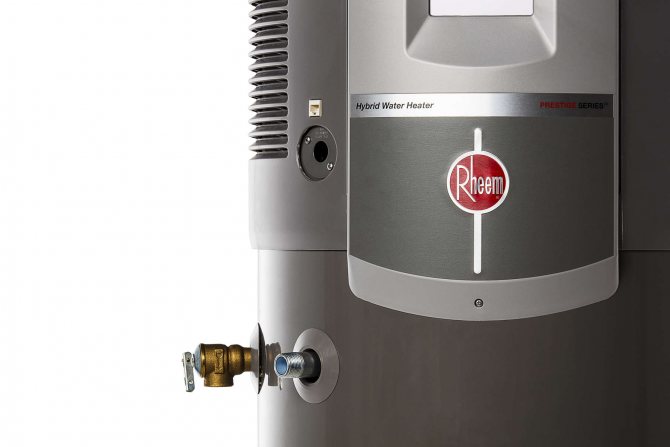

Descaling
Limescale is the most common problem with any heating appliance. But in most cases, almost no one pays attention to the hardness of the water, which subsequently becomes the reason for the breakdown of the boiler. After all, the presence of various impurities in ordinary water at a temperature of 75 contributes to the formation of scale on the heating element and directly on the walls of the device for heating water.
To remove the accumulated lime deposits, it is recommended to use special household chemicals or to use folk methods. Among them are the following:
- lemon acid;
- table vinegar;
- soda with vinegar.
Using these products, you can not only get rid of scale, but also disinfect.
